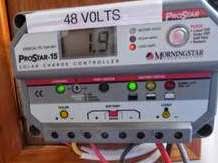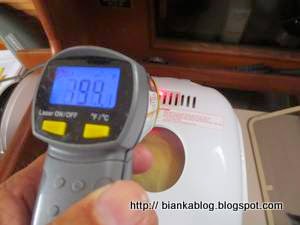With the Ames 48 volt inverter using the Zoriushi is pretty simple. It's small size allows it to easily fit somewhere on the counter as it makes fresh bread. As shown here on BIANKA's slide out surface over the stove:
It has a much smaller footprint and the built in handle makes it much easier to move into storage than the bigger two pound bread makers. It also has a convenient clip on the back to store the power cord:
The clip helps when putting the unit into a locker for storage. Now to move on to the bread making test. I first made sure the 48 volt battery bank was fully charged and the XBM battery monitor was reset to 100%:
The bread maker comes with a large instruction manual and also a DVD for the various recipes. But, it also has a decal on the side with the procedure and ingredient list for the basic bread recipe:
This comes in handy as one does not need to always refer to the written manual just to use the basic bread recipe. After adding the ingredients in the order selected I hit the start button. The unit seemed to just sit there for twenty minutes with the words "Rest" on it's LCD screen:
At first I thought this strange. What is really going on is the Zojirushi is heating up the container and the liquid ingredients to the proper temperature before mixing them with the dry ingredients. Handy since one does not need to preheat the water like on some of the other bread makers. The unit goes through several cycles in the three hour and 40 minutes it takes to make a one pound loaf of fresh bread. There is the mixing/kneading cycle:
Looking at the amp draw from the 48 volt battery bank shows a 1.9 amp draw:
During the rising cycle there is minimal current as the dough is allowed to rise:
It is during the baking cycle where it has it's highest current draw of about nine and a half amps:
Though this is not constant amp draw but, cycles depending on the heat of the baking chamber. Speaking of heat the top of the unit does get quite warm 196 degrees Fahrenheit when measured directly at the vent:
Though the top of the unit is about 50 degrees cooler. Still it's best to keep inquisitive hands away from the unit during baking. After three hours and forty minutes the bread is finished:
In between the cabin has has been filled with the aroma of fresh baked bread. After it was finished baking the bread I took a look at the XBM battery monitor:
Which shows the loaf used about 2.2% of the battery capacity. Which quite easily made up with the solar panels and/or wind turbine.
Checking on other parameters the XBM showed the Zojirushi only used 4.6 amp hours from the 48 volt battery bank. A small amount to expend in order to have fresh bread available on board. I have found that a loaf will last me three or four days including having toast in the morning and a sandwich in the afternoon. I am very pleased with the Zojirushi unit. It also seems to be better built and quieter than the cheaper bread makers. It's compact size makes it ideal for a boat with limited storage space. But, best of all as a sailor who tends to cruise having the ability to make fresh bread also limits the need to head back to shore to re-provision. I can stay in the cockpit enjoying lunch thinking about the parting words of the late Warren Zevon which were to "enjoy every sandwich".
which were to "enjoy every sandwich".





















.jpg)




2 comments:
I have one of the larger Zojirushi bread makers, and it's worked well for a long time... going on 13 years now.
If you use rapid-rise yeast, there's probably a "quick" cycle for bread that will get you bread in about 90 minutes, which means that much less draw from your batteries.
On a side note, thanks for writing all this up! I'm just starting to get back into sailing, after almost 10 years of not having been in a boat, and even longer without having solo sailed. I'll be working with a smaller day-sailer, but I'm now considering an electric outboard as backup, in case the wind is either too low or too high to sail comfortably. Your blog has been a fantastic source of information and inspiration.
Andy:
Thanks for dropping by the blog and your Zorirushi experience. It does seem to be better built and quieter than some of the cheaper models. Not sure the rapid rise yeast will save too much energy since a lot of the time the bread maker is idle letting the dough rise using minimal power. So far I am patient enough to wait. :) I'm very pleased with it as it also stores easily. So far I've made both bread an pizza dough in it. Both are a real treat to have when cruising.
Yeah I'm sold on electric propulsion as auxiliary power on a sailboat. Cleaner, quieter and complements sail power quite nicely. Much more reliable too! Thanks for the kind words.
Fair winds!
Post a Comment